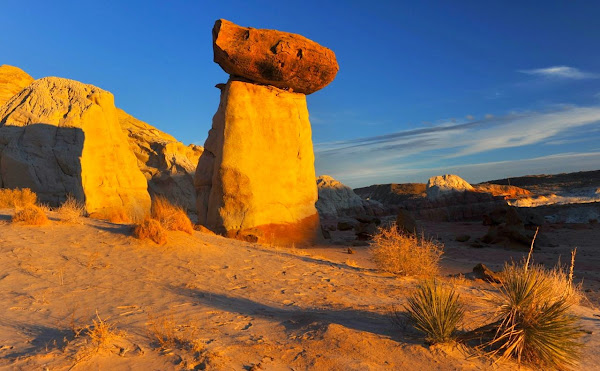Thursday, May 22, 2014
Morning Mist and Spider Web
The early morning mist in Russian Gulch State Park revealed that we were surrounded by thousands of little spiders, each using a horsetail plant as a base for its web.
Seeing all those webs made me wonder how come spiders don't get entangled in and don't stick to their own webs?
The smart creatures weave their webs using both sticky and non-sticky materials. Typically, the radial threads are non-sticky and spiders make sure to travel on them, carefully avoiding the adhesive spiral threads that catch the prey.
Seeing all those webs made me wonder how come spiders don't get entangled in and don't stick to their own webs?
The smart creatures weave their webs using both sticky and non-sticky materials. Typically, the radial threads are non-sticky and spiders make sure to travel on them, carefully avoiding the adhesive spiral threads that catch the prey.
 |
| Early morning mist helps visualize spider's web. |
Wednesday, May 21, 2014
Tuesday, May 20, 2014
Monday, May 19, 2014
Ferns of Van Damme State Park
After tidepooling we went to Van damme State Park were we hiked beautiful Fern Canyon Trail to the Pygmy Forrest.
As the name suggests, the trail was lined with ferns. My favorite fern was northern maidenhair fern (five-fingered fern), which caught my eye due to its unusual curved purple-black stalks and delicate flourescent-green leaves.
As the name suggests, the trail was lined with ferns. My favorite fern was northern maidenhair fern (five-fingered fern), which caught my eye due to its unusual curved purple-black stalks and delicate flourescent-green leaves.
Sunday, May 18, 2014
Tide Pools at Bruhel Point
Apparently, this last weekend was the lowest tide of the year. What a great timing! Not only we were at the coast but also near one of the best tidepooling locations in California: Bruhel Point north of Mendocino/Fort Bragg.
We had so much fun exploring the tide pools that we must have spent there several hours.
The inventory of sea animals and plants we saw includes: giant green and aggregating sea anemones, purple sea urchins, mussels, clams, abalones, gooseneck and acorn barnacles, sea lettuce, rockweed, bull kelp, sea palm, hermit, kelp and seashore crabs, dead man's fingers, bat and ochre sea stars, sculpins, various specious of snails, and even a baby eel.
We had so much fun exploring the tide pools that we must have spent there several hours.
The inventory of sea animals and plants we saw includes: giant green and aggregating sea anemones, purple sea urchins, mussels, clams, abalones, gooseneck and acorn barnacles, sea lettuce, rockweed, bull kelp, sea palm, hermit, kelp and seashore crabs, dead man's fingers, bat and ochre sea stars, sculpins, various specious of snails, and even a baby eel.
Saturday, May 17, 2014
Friday, May 16, 2014
MacKerricher State Park
Last Friday we went camping in MacKerricher State Park.
Even though the campground was full, as soon as we embarked on a 10-mile-long hike along the beach, we haven't met any other people. Instead we saw lots of seals, sea lions, whales, endangered snow plowers, ospreys, as well as miles of ocean, empty beach and dunes. That's what I call perfect holidays :)
Even though the campground was full, as soon as we embarked on a 10-mile-long hike along the beach, we haven't met any other people. Instead we saw lots of seals, sea lions, whales, endangered snow plowers, ospreys, as well as miles of ocean, empty beach and dunes. That's what I call perfect holidays :)
Thursday, May 15, 2014
Wednesday, May 14, 2014
Tuesday, May 13, 2014
Monday, May 12, 2014
Sunday, May 11, 2014
Saturday, May 10, 2014
Friday, May 9, 2014
Thursday, May 8, 2014
Wednesday, May 7, 2014
Mono Lake's Tufas
Tufas (calcium carbonate precipitates) grow exclusively under water.
They can be seen at Mono Lake courtesy to Los Angeles' insatiable water needs, which led to diversion of many of Mono Lake's tributary streams. The diversion halved the water level and doubled the salinity of the lake exposing the tufas.
In case you wonder, I tasted the lake. It tasted more soapy than salty.
They can be seen at Mono Lake courtesy to Los Angeles' insatiable water needs, which led to diversion of many of Mono Lake's tributary streams. The diversion halved the water level and doubled the salinity of the lake exposing the tufas.
In case you wonder, I tasted the lake. It tasted more soapy than salty.





















